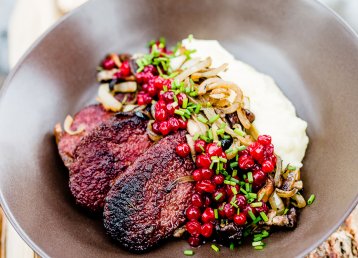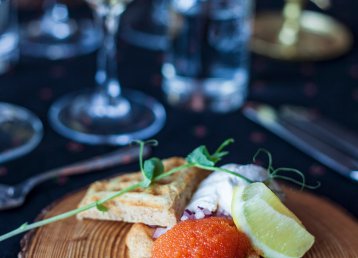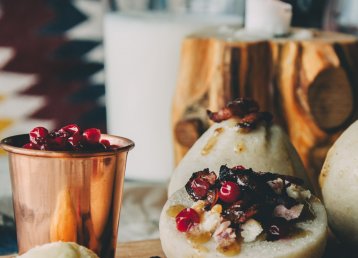Losing touch with life itself
Seasons are important. Patience Gray writes in her now classic cookbook Honey from a Weed that “Good cooking is the result of a balance struck between frugality and liberality… born out in communities where the supply of food is conditioned by the seasons.”
What happens when you lose touch with the seasons is that you lose touch with life itself. Enjoying an unlimited supply of goods, from every corner of the world, at the supermarket is not natural. Autumn’s underground storehouse, on the other hand, filled with potatoes, turnips, carrots, and pickled and canned goods is part of something bigger. It is no coincidence that the people of the books would slaughter a spring lamb for Easter as a symbol of resurrection, of life returning, and fresh food once again being part of everyday life after the hardships of winter. Something just as natural as the Sámi tradition of sacrificing a white reindeer to the godess Beaivi at Midsummer, ensuring that darkness would not prevail and the midnight sun would return the coming year. It is all part of the circle of life. Nothing comes in abundance except for intense periods – in the middle of the season, in autumn, during harvest time, when everything is gathered and stored in barns. It might seem surprising that so many households in the north have four freezers in the basement – one for meat, one for fish, one for berries and mushrooms and then one for discounted goods that will come in handy when there is something to celebrate – but this is actually part of everyday life. Hold on, did we mention the freezer for baked goods?
Memories awakened
Tasty food is eaten twice. First at the table, then in your memory. At Centrum Krog in Piteå, you eat a perfect Surf and Turf, perhaps not a classic Arctic dish but still heavenly, that will awaken memories and make you dream of returning. When Jón Óskar Arnason at Bryggargatan in Skellefteå serves an elk-heart carpaccio from the animal he shot himself a few days earlier, it is also a memorable dinner you would like to relive time and time again.
A stop at Princess Bakery in Sorsele; where you buy laugenbrot sandwiches, just because the Swiss bakery by route E45 will take you to another place; is also an everyday occurrence these days.
"Swedish Lapland has become Scandinavia’s most interesting dining destination."
— Condé Nast Traveler
When you find out that the man from Öland at Niehku Mountain Villa in Riksgränsen, Ragnar Martinsson, is serving elk sausages, you just get in the car and drive. Spending a few hours in the car is nothing when it comes to good sausages! It is also difficult to imagine a summer without netted whitefish at the Kukkola rapids, served fresh at the restaurant, 50 metres from where it was caught.
It is very easy to fall in love with vendace roe, but it might be an even clearer sign of the season when Simon Laiti once again starts serving fried vendace with mashed almond potatoes in September, at his restaurant Hemmagastronomi down by the northern harbour in Luleå.
New Nordic cuisine
Finding ingredients from the north of Sweden in starred restaurants in the south of Sweden is a given, but the chefs we have mentioned have decided to move to – or back to – the ingredients they like working with. The Arctic part of Sweden features locally produced and wild ingredients Of course the destination is famous for its game and local fish, but also for free-range animals. This, however, does not mean that Europe’s most progressive destination is blind to other trends. Bistron in Luleå is a green oasis, at the Christmas smorgasbord at Brändön you find more and more vegan dishes, and Miss Voon in Skellefteå serves reindeer as sashimi – but you also get tuna and scallops. The new Nordic cuisine is celebrated for components that are smoked, pickled, salted, and freshly prepared over an open fire. Even if that is the traditional way in an Arctic context, the cuisine has always changed in line with how the world changes. Johan Eriksson at Centrum Krog says, when asked:
“Locally produced is our base. We get more or less all our meat from Nyhléns Hugosons in Norrbotten. But I love making good food, that’s why I became a chef, so taking ideas from elsewhere and adapting them to your own conditions is something natural.”
When Johan makes his umami-rich XO sauce he skips the dried seafood and uses dried reindeer as the main ingredient instead. Something traditional from the Asian cuisine suddenly becomes Arctic. This was picked up on by American food writer Lane Nieset when she visited Piteå, and she asked a bashful chef for the recipe.
Artisan cheese
This is a story of how and why to make artisan cheese in Sweden. West of Skellefteå in Swedish Lapland, in a village called Svedjan, you’ll find a farm with some cows, sheep and cats, along with a summer café and in the centre of it all, the small diary for — Svedjan Ost.
A food spree
A few months later both the sauce and the destination were celebrated in Condé Nast Traveler. Lane Nieset’s headline “Swedish Lapland has become Scandinavia’s most interesting dining destination” sums up a food spree through the destination ending at Eva Gunnare’s place in Jokkmokk. Eva has become a household name over the years when it comes to foraging. She moved from Stockholm to Kvikkjokk some 25 years ago, which was where she first encountered traditional Sámi cuisine. A few years later her curiosity inspired her to look for the more forgotten Arctic cuisine. What herbs, plants and berries did the Sámi and settlers depend on? Today in Eva’s home, during a 22-course spread called Njálgge, you will be presented with alpine bistort, wood sorrel, dandelion buds, and angelica. You will drink mulled wine made from meadowsweet and cordial made from willowherb. The stem from willowherb is even served as a kind of tasty asparagus to complement the freshly slaughtered reindeer. The superberries are present, of course: lingonberry, blueberry, cloudberry, bilberry and hagberry in various forms.
Under the midnight sun
The concept superberries was a hot topic some years ago. In the north, there is nothing strange about superberries. Studies have shown that both lingonberries and sea buckthorn berries help keep your weight in check. Blueberries, given their blue colour from the antioxidant anthocyanin, are credited with all kinds of good qualities – among them improved vision. Even without dissecting these berries and plants into smaller parts, we can state something very important: they are very dependent on sunlight! In an arctic climate the growth period is short, and therefore extremely intense. The world’s northernmost mustard farmer, Per Pesula in Kukkola, might explain it best as he states:
“In summer, thanks to the midnight sun we have three months of growth during two calendar months. It’s bound to do something to the plants.”
In Norsjö outside Skellefteå, Rålund produces a wine from lingonberries and blueberries that has been well received, and in Öjebyn they make Svart, a bubbly made from black currants. We will get back to that.
Super berries and how to eat them
In the forests of Swedish Lapland super berries are to be found here and there. We had the chance to hang out with Eva Gunnare for a day, a true master of organic food.
The world’s best meat
Rural development specialist Jenny Bucht in Bertnäs outside Piteå used to work for the Norrbotten County Board, coordinating the region’s food strategy. These days Jenny is both a sheep farmer and a consultant focusing on sustainability issues. She continues where Per Pesula left off:
“Thanks to our midnight light we have a very intense growth period, that brings out the best in the produce. Anyone who remembers photosynthesis, from their biology classes, knows that it is the sun that is driving the process. What happens during this growth period is that plants, grass, trees, berries and more are filled with a lot of energy during a short timeframe.”
"Well, in short you could say that we have the best grass in the world and that’s why we produce the world’s best fodder, which naturally would lead to the world’s best meat"
— Jenny Bucht
Then she sums up: “Well, in short you could say that we have the best grass in the world and that’s why we produce the world’s best fodder, which naturally would lead to the world’s best meat.”
Jenny Bucht concludes that the northernmost region has not always been that good at understanding or communicating the unique, sustainable environment and its effect on food quality. Look at wild animals and freely grazing reindeer, how they spend summer and autumn eating and then starve in winter. This means the reindeer recycles its fat during the course of a year. In turn, that gives you a meat that’s been minimally affected by the environment. Jenny’s lambs, by the way, make an appearance every now and then at Johan’s restaurant Centrum Krog.
The dream of a good life
In recent years, fire has started to play a more prominent role in the kitchen. No, we are not referring to the constant smell of barbecues filling camp sites and neighbourhoods as soon as summer approaches. Instead, fire has become part of the identity for famous Michelin-star restaurants and your local pizza place.
In the north, cooking over an open fire is something completely normal. If you take a walk in the forest, you make a fire and boil some coffee. If not, almost no one would count it as having been outside properly. Even in the middle of town, houses will often have a fireplace or barbecue hut outside to experience outdoor life without even leaving home. Fire is central to the dream of a good life in the north – for cooking, or for a sauna. These days it is part of the current trend at Michelin-star restaurants featuring the new Nordic cuisine. And during the ambulating food festival Stars du Nord, celebrated under the northern lights outside Storklinten in autumn 2022, nine of the best Nordic chefs showed how to make good food using fire, no electricity, and no running water. An amazing experience in every way.
‘Méthode traditionelle’
Hushållningssällskapet, The Rural Economy and Agricultural Society, runs an experimental farm in Öjebyn outside Piteå where research is carried out. In cooperation with SLU, the Swedish University of Agricultural Sciences, 400 different varieties of turnip rape have been cultivated to see which variety likes it best here in the arctic climate. But even more interesting is the trial using pheromones to combat pests. Mikael Kivijärvi, former CEO of the society and currently project manager for its innovative and land-based fish farms, says:
“Hushållningssällskapet has tried using various forms of biodynamic pest control, even coating black currant plantations with turnip rape oil, but this project where pheromones are used among the berries has shown exciting results”.
The organic black currants from Öjebyn are actually worth another mention. They are used to make a sparkling wine from black currents according to the ‘méthode traditionelle’, the same way champagne and cava (among others) is made, which requires a lot of labour and precision. But the result is, according to the wine expert at Swedish newspaper Svenska Dagbladet, a “dry and refreshing wine… with notes of iron, raspberry and tart berries”. Just perfect for the Christmas smorgasbord, according to the same expert.
From blackcurrents that become bubbly and turnip rape that could turn into farm-produced oil, we move on to Michael’s core activity: fish farming.
“Everything suggests that there will be land-based fish farming in the future. Simply because you can regulate the process in a different manner. With land-based farming you can control animal health, the spread of diseases, the water environment, escapees and so on. You can also use the water for irrigation, so-called aquaponics, or use the residue after water treatment as a base for feed or fertilizer.”
The story of Kalix löjrom
Ten years from this date, November 12, 2010, Kalix Löjrom became Sweden’s first staple food to be approved Protected Designation of Origin. And this calls for celebrations. The wonderful caviar, from the world’s smallest salmonid, is often served at the best restaurants in Swedish Lapland. And this is how it’s done.
A kind of winter garden
At the old military site AF1 in Boden, home to Boden’s Army Air Battalion until the beginning of the 21st century, there is a kind of winter garden. The 300-square-metre building is heated by residue heat from a data center where they mine cryptocurrency using blockchain technology.
“This is just a test facility. The idea is having a much larger greenhouse,” says Håkan Nordin, business developer at Boden municipality and continues:
“It wasn’t profitable before to use the residue heat from the server farm for district heating. The temperature of 40 degrees Celsius just wasn’t enough. But this, using it for a greenhouse, means it’s warm enough”.
"The idea is simply to try to grow everything here that Sweden is importing at the moment, to see what works"
— Håkan Nordin
In Boden they experiment with what will be, or could be, grown. The idea is to try to grow mango, banana, passion fruit and more, to see how it goes.
“The idea is simply to try to grow everything here that Sweden is importing at the moment, to see what works. It’s a way of improving our degree of self-sufficiency without having to forgo what we’re used to eating these days.”
If everything works out well at the old military base they will continue and build a 3,000-square-metre installation that will also work as an aquaponic farm. As mentioned, a kind of farm where nutrient-rich water from land-based fish farms is circulating around vegetables being grown. The greenhouse is cutting-edge not only because it uses residual heat, the AI-based growing technique that continuously checks the plants is also expected to reduce cultivation losses by up to 30%.
This future scenario gets even more exciting when considering the investments made in Boden. H2 Green Steel’s new hydrogen-producing steel plant is Sweden’s largest industrial project: a 600-hectare area – the largest development plan in Sweden – with 70 hectares set aside for further development of greenhouses and cultivation. But Boden sees this cultivation as more than just a sustainability project in environmental terms – which it is, of course, as Dutch tomatoes transported by lorry to north Sweden in winter are grown in greenhouses heated by foreign gas and then driven 2,000 kilometres north using diesel. It is as important that this large-scale project that will bring both social and financial sustainability: creating entry-level jobs and increased self-sufficiency.
Perhaps this creates a discrepancy in our story, that started with the advantages of the midnight sun and the seasonality that has created an Arctic way of life and constitutes the base of the new Nordic cuisine, to talking about large-scale greenhouses of the future. But on the other hand: development does not cease on the outskirts of the modern world. Rather, it could be driven from here.
What constitutes good food
In Piteå, at the parking area by Västra kajen, a number of food artisans gather on a Wednesday night in February. This is a kind of farmers’ market known as Reko-ring, and people from near and far come to shop for locally produced products. Anders Skum and his Fjällvilt from Ammarnäs is here. The award-winning food artisan says that during the pandemic this Reko-ring saved his finances. Similar setups to Reko-ring are available in many other locations now. This evening the farm Strömnäsgården from near Harads is present too, with chickens and eggs from Norrbotten’s first foraging chickens, as well as outdoor pigs from Järvtjärn and Vuollerim’s Mathantverk.
Reko-ring is a concept that has grown using social media and current awareness of what constitutes good food. In Burträsk village, the farmers have started their own farmers’ market where members take turns during opening hours. You can find everything there, from cutlets from outdoor pigs to rabbit fillets and Kielbasa sausages made using original Polish recipes. In Boden there is another farmer’s market.
Åsa Lindman and Magnus Eriksson who run Strömnäsgården say the reason why they began to keep chickens and later cattle was simply that they wanted to know what they were eating. And conclude:
“But we also love living in the countryside”.
Less than an hour’s drive from Strömnäsgården, up the Lule River towards Jokkmokk, is Vuollerims Mathantverk. They produce an award-winning cheese using milk from mountain cows. This region, with the world’s best grass, or fodder, has many products to offer with clean water and an air of world-class quality. A lot of it thanks to the summer season under the midnight sun.
Dinner in the midst of nature
Why does food taste better when you are eating out in nature? Maybe because all your senses are activated by what’s around. The sound and the smell and the feel. Maybe also because this is where food comes from. That’s the philosophy at Huuva Hideaway.





































